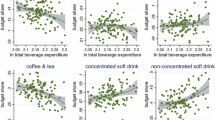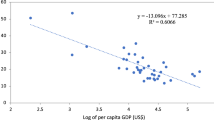Abstract
The Inverse Almost Ideal Demand System (IAIDS) model of Moschini and Vissa (1992) and Eales and Unnevehr (1994) is extended to include: (1) general, nonlinear, nonadditive habit effects; and (2) a specification for habit stock terms that allows purchases from the distant past to influence current consumption (long memory). The resulting models are compared with a linear habit effects model and a static specification. The empirical estimation is on U.S. quarterly meat expenditures (1961–1993), with each model being subjected to a battery of misspecification tests. Results of these tests, along with tests of homogeneity and symmetry restrictions, indicate clearly that the most generalized dynamic specification-the one with nonlinear, nonadditive long-memory habit stock effects-is preferred. Furthermore, persistence effects are found to be qualitatively important in that flexibility, consumption scale, and habit flexibility estimates differ, in some instances substantially, between alternative specifications.
Similar content being viewed by others
References
Alessie R, Kapteyn A (1991) Habit formation, interdependent preferences and demographic effects in the almost ideal demand system. Economic Journal 101:404–419
Anderson GW, Blundell RW (1982) Estimation and hypothesis testing in dynamic singular equation systems. Econometrica 50:1559–1571
Anderson GW, Blundell RW (1983) Testing restrictions in a flexible dynamic demand system: An application to consumers' expenditure in Canada. Review of Economic Studies 50:397–410
Arzac ER, Wilkinson M (1979) A quarterly econometric model of the United States livestock and feed grain markets and some of its policy implications. American Journal of Agricultural Economics 61:297–308
Barten AP (1969) Maximum likelihood estimation of a complete system of demand equations. European Economic Review 1:7–73
Barten AP (1993) Consumer allocation models: Choice of functional form. Empirical Economics 18:129–158
Barten AP, Bettendorf LJ (1989) Price formation of fish: An application of an inverse demand system. European Economic Review 33:1509–1525
Berndt ER, Savin NE (1975) Estimation and hypothesis testing in singular equation systems with autoregressive disturbances. Econometrica 43:931–957
Blanciforti L, Green R (1983) An almost ideal demand system incorporating habits: An analysis of expenditures on food and aggregate commodity groups. Review of Economics and Statistics 65:511–515
Breusch TS (1978) Testing for autocorrelation in dynamic linear models. Australian Economic Papers 17:334–355
Brown MG, Lee, J-Y, Seale JL, Jr. (1995) A family of inverse demand systems and choice of functional form. Empirical Economics 20:519–530
Chambers RG, McConnell KE (1983) Decomposition and additivity in price dependent demand systems. American Journal of Agricultural Economics 65:596–602
Chavas J-P, Klemme RM (1986) Aggregate milk supply response and investment behavior on U.S. dairy farms. American Journal of Agricultural Economics 68:55–66
Christensen LR, Jorgenson, DW, Lau LJ (1975) Transcendental logarithmic utility functions. American Economic Review 65:367–383
Christensen LR, Manser ME (1977) Estimating U.S. consumer preferences for meat with a flexible utility function. Journal of Econometrics 5:37–53
Davidson R. MacKinnon J. (1993) Estimation and inference in econometrics. Oxford University Press New York
Deaton A (1979) The distance function in consumer behavior with applications to index numbers and optimal taxation. Review of Economic Studies 47(1979):391–405
Deaton A, Muellbauer J (1980a) Economics and consumer behavior. Cambridge University Press Cambridge
Deaton A, Muellbauer J (1980b) An almost ideal demand system. American Economic Review 70:312–326
Eales JS (1994) The inverse Lewbel demand system. Journal of Agricultural and Resource Economics 19:173–182
Eales JS, Unnevehr L (1994) The inverse almost ideal demand system. European Economic Review 38:101–115
Engle RF (1982) Autoregressive conditional heteroskedasticity with estimates of the variance of U.K. inflation. Econometrica 50:987–1008
Geweke J (1986) Exact inference in the inequality constrained normal linear regression model. Journal of Applied Econometrics 1:127–141
Green RD, Hassan ZA, Johnson SR (1978) Maximum likelihood estimation of linear expenditure systems with serially correlated errors European Economic Review 11:207–219
Godfrey LG (1978) Testing for higher order serial correlation in regression equations when the regressors include lagged dependent variables. Econometrica 46:1303–1310
Holt MT, Skold K (1989) Dynamic elasticities and flexibilities in a quarterly model of the U.S. hog industry. Applied Economics 21:1683–1700
Holt MT, Goodwin BK (1996) Dynamic generalizations of inverse almost ideal demand systems: An application to meat expenditures in the United States. Department of Agricultural and Resource Economics Working Paper, North Carolina State University, Raleigh
Holt MT, Aradhyula S (1997) Endogenous risk in rational-expectations commodities models: A multivariate generalized ARCH-M approach. Journal of Empirical Finance, forthcoming
Heien D, Durham C (1991) A test of the habit formation hypothesis using household data. Review of Economics and Statistics 73:189–199
Huang KS (1988) An inverse demand system for U.S. composite foods. American Journal of Agricultural Economics 70:902–908
Johnson SR, Green RD, Hasan Z, Safyurtlu AN (1986) Market demand functions. In Capps O Jr, Senauer B (eds) Food demand analysis: Implications for future demand functions, Virginia Polytechnic Institute and State University
Kastens TL, Brester GW (1996) Model selection and forecasting ability of theory-constrained food demand systems. American Journal of Agricultural Economics 78:301–312
Kesavan T, Buhr B (1995) Price determination and dynamic adjustments: An inverse demand system approach to meat products in the United States. Empirical Economics 20:681–698
LaFrance JT (1996) Empirical separability Department of Agricultural and Resource Economics Working Paper, University of Arizona, Tucson
Ljung GM, Box GEP (1978) On a measure of lack of fit in time series models. Biometrika 65:297–303
Lütkepohl H (1993) Introduction to multiple time series analysis: Second edition. Springer-Verlag, Berlin
Maddala GS (1992) Introduction to econometrics: Second edition. Macmillan Publishing Company New York
Manser ME (1976) Elasticities of demand for food: An analysis using non-additive utility functions allowing for habit formation. Southern Economic Journal 43:879–891
McCarthy M (1974) On the stability of dynamic demand functions. International Economic Review 15:256–259
McGuirk A, Driscoll P, Alwang J, Huang H (1995) System misspecification testing and structural change in the demand for meats. Journal of Agricultural and Resource Economics 20:1–21
McLaren KR, Fry JM, Fry TRL (1995) A simple nested test of the almost ideal demand system. Empirical Economics 20:149–161
Moschini G, Vissa A (1992) A linear inverse demand system. Journal of Agricultural and Resource Economics 17:294–302
Moschini G, Moro D (1994) Autocorrelation specification in singular equation systems. Economics Letters 46:303–309
Phlips L (1972) A dynamic version of the linear expenditure model. Review of Economics and Statistics 54:450–458
Pollak RA, Wales TJ (1969) Estimation of the linear expenditure system. Econometrica 37:611–628
Pollak RA, Wales TJ (1992) Demand system specification and estimation, Oxford University Press, New York
Pollak RA (1970) Habit formation and dynamic demand functions. Journal of Political Economy 78:745–763
Pope R Green R, Eales J (1980) Testing for homogeneity and habit formation in a flexible demand specification of U.S. meat consumption. American Journal of Agricultural Economics 62:778–784
Ramsey JB (1969) Tests for specification errors in classical linear least squares regression analysis. Journal of the Royal Statistical Society, Series B 31:350–371
Ray R (1984) A dynamic generalisation of the almost ideal demand system. Economics Letters 14:235–239
Ray R (1985) Specification and time series estimation of dynamic gorman polar form demand systems. European Economic Review 27:357–374
White H (1980) A heteroskedasticity consistent covariance matrix estimator and a direct test of heteroskedasticity. Econometrica 48:817–838
Wold H (1954) A study in the analysis of stationary time series, 2nd ed. Almquist and Wicksell, Uppsala.
Author information
Authors and Affiliations
Additional information
The authors are associate professors in the Department of Agricultural and Resource Economics at North Carolina State University. This work has been supported by the North Carolina Agricultural Research Service. We are grateful to two anonymous referees for helpful remarks on an carlier version.
Rights and permissions
About this article
Cite this article
Holt, M.T., Goodwin, B.K. Generalized habit formation in an Inverse Almost Ideal Demand System: An application to meat expenditures in the U.S.. Empirical Economics 22, 293–320 (1997). https://doi.org/10.1007/BF01205360
Received:
Revised:
Issue Date:
DOI: https://doi.org/10.1007/BF01205360




